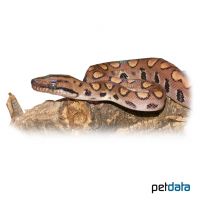Rainbow Boa (Epicrates cenchria cenchria)
| Rainbow Boa Epicrates cenchria cenchria | |
|---|---|
| Name | Rainbow Boa |
| Name Lat. | Epicrates cenchria cenchria |
| Family | Boas |
| Family lat. | Boidae |
| Order | Scaled Reptiles |
| Order lat. | Squamata |
| Origin | South America |
| Habitat | Rainforests |
| Diet | Small mammals |
| Humidity | 60-90 % |
| Behavior | Nocturnal, peaceful |
| Keeping | Individual, pair, group |
| Care Level | Moderate |
| Reproduction | Viviparous |
| Housing | Humid terrarium |
| Life Span | 15-20 years |
| Protection | CITES Appendix II; EU Annex B |
| Metric Units | |
| Size | 150-180 cm |
| Temperature | 28-30 °C |
| Temperature Local | 30-33 °C |
| Housing Size | 150 x 80 x 120 cm |
| US Units | |
| Size | 59"-71" |
| Temperature | 82-86 °F |
| Temperature Local | 86-91 °F |
| Housing Size | 60" x 30" x 45" |
Distribution and habitat
The range of the partially arboreal, crepuscular to nocturnal red rainbow boas is Venezuela, Guyana and Brazil, where they live primarily in tropical rainforests.
Maintenance
Minimum dimensions for the terrarium, according to the size and number of animals:
| 1-2 animals | 0,75KL x 0,5KL x 0,75KL (L x W x H) |
Body length (KL) is measured on the largest animal. For each additional animal the floor space should be increased by 20%. A terrarium of e.g. L 150 x W 80 x H 120 cm is recommended, which should be placed in a quiet and vibration-free place.
They need a terrarium structured with large roots, horizontal climbing branches, bamboo sticks and cork tubes (hiding places and visual protection) with a moisture-retaining substrate, e.g. of peat-soil mixture with foliage, as well as a large, easy-to-clean water basin as drinking and bathing possibility. Half of the substrate should always be kept slightly moist. Once a day, preferably in the evening, the inside of the terrarium should be finely sprayed with water (humidity), but a rain or mist system is better.
| Temp. day: 28-30 °C | Temp. night: 22-25 °C | Temp. local: up to 33 °C | Humidity: 60-90 |
Thermostatically controlled floor heating is recommended. Lighting duration must be 12-14 hrs. depending on the season. Daylight fluorescent tubes are ideal.
Diet
According to their size, they feed on mice, rats, guinea pigs and other rodents, as well as chicks and small pigeons. After acclimation, they often succeed in switching to dead food animals. Juveniles should be offered food every 8-10 days and adults every 14-20 days, with occasional periods of fasting (e.g., skipping a feeding). If the snake is disturbed after feeding, this may result in vomiting of the prey. Generally, it is better to offer several small feeders, rather than one large one. If it does not eat for a long period of time, both the timing and the food should be varied. It is important to fortify the food animals with vitamins and minerals. Since the snake could be injured by live rodents, it should not be left unattended with them.
Reproduction and breeding
Probing by the veterinarian is the only reliable method of sex determination. They are viviparous (ovoviviparous). The gestation period is 4-5 months, the fully developed 15-20 young are 40-50 cm long and can be fed young mice
Life expectancy can be 15-20 years.
Species protection
The animal population must be reported in writing to the responsible authority immediately after the beginning of the keeping. It is essential to find out about any bans on keeping or permits for keeping dangerous animals in your state or municipality (e.g. public order office)
Protection of species: WA Annex II; EU Annex B. The proof of purchase is the required proof of origin for the animal. Please keep it safe! Your pet store will be happy to provide you with further information.
Important
They are peaceful and compatible with each other. With their smooth scales they shimmer in all colors of the rainbow. In captivity they rarely reach a length over 1.5 m. If the air temperature in the terrarium is lower than the temperature in the water tank, there is a risk of respiratory infection. For the resting phase, shorten the lighting time by 2-4 hours and lower the temperature by 3-4 °C for 1-2 months
Always have snake hooks, protective gloves and cold water ready when handling.
The terrarium must have good ventilation without drafts and meet the species specific needs. Measuring devices such as thermometers, hygrometers, etc. are necessary. The lighting has to correspond to the species-specific day-night rhythm and has to be placed in such a way that the animals cannot injure themselves. The terrarium should be locked in such a way that neither unauthorized persons can open it nor the animals can escape. Contamination must be removed regularly
Further literature can be found in your pet store.
References
Text: Christian Sänger; Image: petdata
Source: BMELV (1997): Tierschutzgutachten - Mindestanforderungen an die Haltung von Reptilien; ENGELMANN (2006): Zootierhaltung - Tiere in menschlicher Obhut: Reptilien und Amphibien, Harri Deutsch Verlag
- Gemäß § 21 Abs. 5 Tierschutzgesetz idgF
